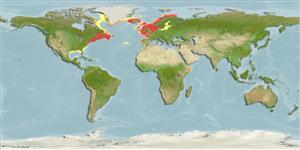Environment: milieu / climate zone / depth range / distribution range
Ecologia
marino demersale; oceanodromo (Ref. 51243); distribuzione batimetrica 20 - 650 m (Ref. 6144), usually 20 - 50 m. Temperate; 73°N - 20°N, 99°W - 32°E (Ref. 1371)
Eastern Atlantic: from Norway, Greenland and Iceland south to British Isles and northern Bay of Biscay, including the North Sea and the southern Baltic Sea (70°N to 20°N). Western Atlantic: from Greenland to northern Gulf of Mexico (Ref. 125219). Reported from Estonia (Ref. 33247).
Length at first maturity / Size / Peso / Age
Maturity: Lm 25.0, range 15 - ? cm
Max length : 41.0 cm TL maschio/sesso non determinato; (Ref. 1371); common length : 30.0 cm TL maschio/sesso non determinato; (Ref. 1371); Età massima riportata: 9 anni (Ref. 1371)
Spine dorsali (totale): 0; Spine anali 0. One barbel on chin, one on tip of snout, and one at each of the anterior nostril. First dorsal fin ray very elongate, followed by a row of small, fleshy filaments. Color varies from dusky to pale.
Sedentary bottom dwellers on muddy sand between patches of hard substrate, or on the soft, smooth ground of deep sinks on the continental slopes of both sides of the North Atlantic. Feed on flatfishes, amphipods, decapods, copepods, mysids, shrimps, isopods and other small crustaceans. Spawn in the Baltic Sea (Ref. 35388). Mixed with soups and other products hot-smoked (Ref. 1371).
Spawning has been recorded in waters less than 140 m deep. Fecundity ranges from 5,000 - 45,000.
Cohen, D.M., T. Inada, T. Iwamoto and N. Scialabba, 1990. FAO species catalogue. Vol. 10. Gadiform fishes of the world (Order Gadiformes). An annotated and illustrated catalogue of cods, hakes, grenadiers and other gadiform fishes known to date. FAO Fish. Synop. 125(10). Rome: FAO. 442 p. (Ref. 1371)
IUCN Red List Status (Ref. 130435)
Threat to humans
Harmless
Human uses
Pesca: scarso interesse commerciale
Strumenti
Special reports
Download XML
Fonti Internet
Estimates based on models
Preferred temperature (Ref.
123201): 4.1 - 13.8, mean 10 °C (based on 715 cells).
Phylogenetic diversity index (Ref.
82804): PD
50 = 1.0000 [Uniqueness, from 0.5 = low to 2.0 = high].
Bayesian length-weight: a=0.00407 (0.00242 - 0.00685), b=3.06 (2.92 - 3.20), in cm total length, based on LWR estimates for this species & (Sub)family-body (Ref.
93245).
Trophic level (Ref.
69278): 3.5 ±0.0 se; based on diet studies.
Resilienza (Ref.
120179): Medio, tempo minimo di raddoppiamento della popolazione 1.4 - 4.4 anni (K=0.20-0.25; tm=3; tmax=9; Fec=5,000).
Fishing Vulnerability (Ref.
59153): Moderate to high vulnerability (46 of 100).
Climate Vulnerability (Ref.
125649): Low vulnerability (6 of 100).
Nutrients (Ref.
124155): Calcium = 38.2 [18.6, 84.5] mg/100g; Iron = 0.329 [0.174, 0.696] mg/100g; Protein = 17.1 [15.4, 18.9] %; Omega3 = 0.42 [0.22, 0.77] g/100g; Selenium = 20.1 [10.3, 42.2] μg/100g; VitaminA = 13.6 [3.2, 52.4] μg/100g; Zinc = 0.564 [0.390, 0.882] mg/100g (wet weight);
